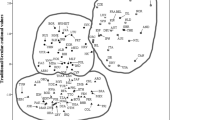Abstract
This chapter reports the analysis of the distribution and characteristics of the segments of people associated with the symbolic universes. Analyses comprise seven countries are in Cyprus, Denmark, Estonia, Greece, Italy, Netherlands, United Kingdom. The aim of these analysis is to understand if and to what extent socio-demographic and psycho-social factors that could play a role in moderating the impact of policies are associated with specific symbolic universes. Main findings: (a) the distribution of the different cultural segments differs quite a lot across countries, though the Niche of belongingness cultural segment appear as the most or one of the most frequent in all countries under analysis; (b) as to the socio-demographic profiles of the cultural segments, niche of belongingness and others’ world—i.e. the cultural segments characterized for the most negative worldviews—are associated with worse living conditions—low level of education, high unemployment or low quality of employment; negative self-evaluation of own health; moreover, they present a low level of (self-evaluated) positive personality traits, a low sense of interpersonal and community linkages, negative attitude towards foreigners. Conversely, ordered universe and interpersonal bond have a rather similar profile, characterized by young, highly educated people having a high quality occupational status and satisfaction with their health; moreover, these two cultural segments present positive personality characteristics as well as high level in the psycho-social capacity to valorise and make interpersonal and community life meaningful.
Access this chapter
Tax calculation will be finalised at checkout
Purchases are for personal use only
Similar content being viewed by others
References
Costarelli, S. (2011). Seeming ambivalent, being prejudiced: The moderating role of attitude basis on experienced affect. Group Dynamics: Theory, Research, and Practice, 15(1), 49–59.
Gosling, S. D., Rentfrow, P. J., & Swann, W. B., Jr. (2003). A very brief measure of the big five personality domains. Journal of Research in Personality, 37, 504–528.
Heft, H. (2013). Environment, cognition, and culture: Reconsidering the cognitive map. Journal of Environmental Psychology, 33, 14–25.
Lucas, T., Zhdanova, L., & Alexander, S. (2011). Procedural and distributive justice beliefs for self and others: Assessment of a four-factor individual differences model. Journal of Individual Differences, 32, 14–25.
Meertens, R. M., & Lion, R. (2008). Measuring an individual’s tendency to take risks: The risk propensity scale. Journal of Applied Social Psychology, 38(6), 1506–1520.
Peterson, N. A., Speer, P. W., & McMillan, D. W. (2008). Validation of a brief sense of community scale: Confirmation of the principal theory of sense of community. Journal of Community Psychology, 1, 61–73.
Salvatore, S., & Venuleo, C. (2013). Field dependency and contingency in the modelling of sensemaking. Papers on Social Representation [On Line Journal], 22(2), 21.1–21.41.
Schwarzer, R., & Jerusalem, M. (1995). Generalized Self-Efficacy scale. In J. Weinman, S. Wright, & M. Johnston (Eds.), Measures in health psychology: A user’s portfolio. Causal and control beliefs (pp. 35–37). Windsor, UK: NFER-NELSON.
Zimet, G. D., Dahlem, N. W., Zimet, S. G., & Farley, G. K. (1988). The multidimensional scale of perceived social support. Journal of Personality Assessment, 52(1), 30–41.
Author information
Authors and Affiliations
Corresponding author
Editor information
Editors and Affiliations
Annex 1: Characteristics of Cultural Segments. Output of Statistical Analyses
Annex 1: Characteristics of Cultural Segments. Output of Statistical Analyses
1.1 Preliminary Factorial Analyses
1.2 Comparisons Among Symbolic Universes on Socio-demographic Characteristics
See Tables 4.4, 4.5, 4.6, 4.7, 4.8 and 4.9.
1.3 Comparisons Among Symbolic Universes on Psycho-social Characteristics
See Tables 4.10, 4.11, 4.12 and 4.13.
Rights and permissions
Copyright information
© 2019 Springer Nature Switzerland AG
About this chapter
Cite this chapter
Salvatore, S. et al. (2019). Distribution and Characteristics of Symbolic Universes Over the European Societies. In: Salvatore, S., Fini, V., Mannarini, T., Valsiner, J., Veltri, G. (eds) Symbolic Universes in Time of (Post)Crisis. Culture in Policy Making: The Symbolic Universes of Social Action. Springer, Cham. https://doi.org/10.1007/978-3-030-19497-0_4
Download citation
DOI: https://doi.org/10.1007/978-3-030-19497-0_4
Published:
Publisher Name: Springer, Cham
Print ISBN: 978-3-030-19496-3
Online ISBN: 978-3-030-19497-0
eBook Packages: Social SciencesSocial Sciences (R0)




